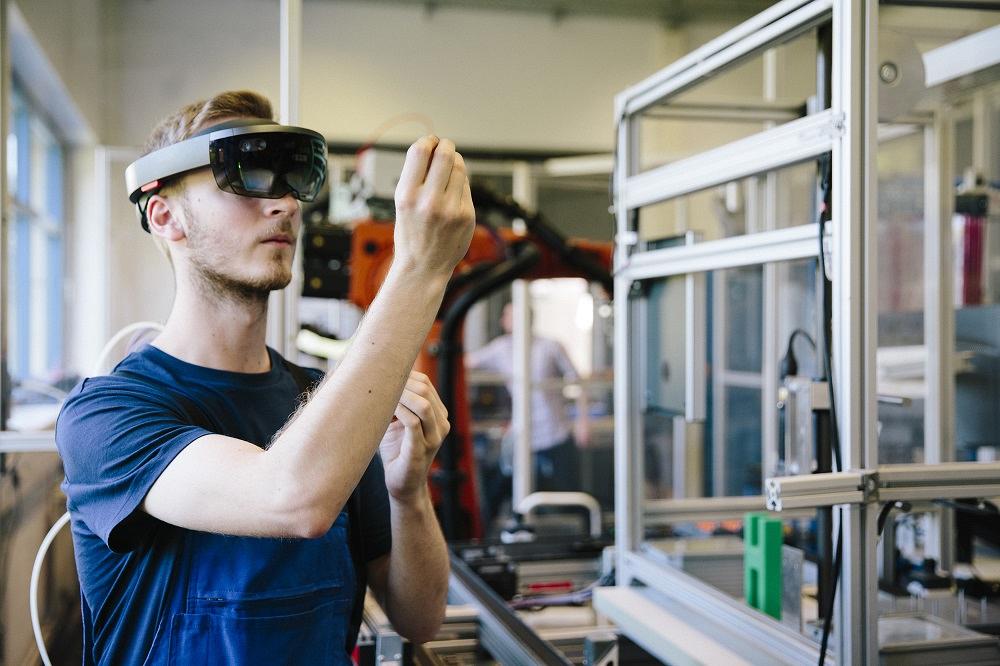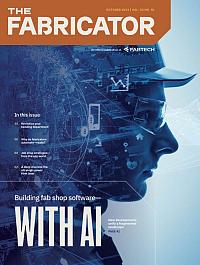Director of Smart Manufacturing
- FMA
- The Fabricator
- FABTECH
- Canadian Metalworking
Categories
- Additive Manufacturing
- Aluminum Welding
- Arc Welding
- Assembly and Joining
- Automation and Robotics
- Bending and Forming
- Consumables
- Cutting and Weld Prep
- Electric Vehicles
- En Español
- Finishing
- Hydroforming
- Laser Cutting
- Laser Welding
- Machining
- Manufacturing Software
- Materials Handling
- Metals/Materials
- Oxyfuel Cutting
- Plasma Cutting
- Power Tools
- Punching and Other Holemaking
- Roll Forming
- Safety
- Sawing
- Shearing
- Shop Management
- Testing and Measuring
- Tube and Pipe Fabrication
- Tube and Pipe Production
- Waterjet Cutting
Industry Directory
Webcasts
Podcasts
FAB 40
Advertise
Subscribe
Account Login
Search
Lean principles help to streamline assembly operations
Optimized work areas and an empowered workforce unleash new efficiencies when it comes to configuring components or finished products
- By Eric Whitley
- October 6, 2023
- Article
- Assembly and Joining

Augmented reality headsets can deliver assembly instructions that expedite the learning of an assembly process. fotografixx/E+
The dawn of the 21st century has ushered in a renewed focus on prioritizing efficiency and waste minimization in the manufacturing sector. Amidst this backdrop, lean manufacturing philosophies have emerged as valuable tools for the industry. They allow manufacturers to streamline processes, reduce waste, and enhance overall productivity.
At the heart of any successful manufacturing endeavor lies a streamlined assembly process. To get there, manufacturers can’t consult a traditional methodology written down in a book. Lean assembly focuses on a holistic approach that combines historical insights with cutting-edge strategies.
Understanding and harnessing the tenets of lean assembly can spell the difference between stagnation and transformative growth for a metal fabricating company looking to grow with its customers. To become more well-rounded suppliers to customers, metal fabricators need to pivot toward approaches that not only prioritize efficiency, but also champion adaptability and foresight. If they learn to streamline assembly operations, companies can feel confident in bringing in more of this type of work and build more solid relationships with their OEM customers.
Core Principles of Lean Assembly
Historically, the metal forming and fabricating industry has been about transformation—from raw materials to intricate components. One of the major changes that has occurred over the years has been a shift from delivering disparate parts to full-fledged integrated components. This evolution underscores the need for more streamlined operations.
Yet, as the mechanics of production shifted, the foundational principles of lean manufacturing as applied to the task of assembly crystallized:
- Value creation and customer focus - Beyond mere production, lean assembly stresses the importance of aligning with customer needs and delivering exceptional value.
- Minimized waste - The elimination of unnecessary elements, from surplus inventory to redundant operations, is a focal point.
- Continuous improvement - Resting on laurels is antithetical to lean assembly. The philosophy mandates a culture of unceasing refinement and adaptation.
- Efficient workflows - Assembly isn’t just about movement; it’s about orchestrated, strategic flow, ensuring each step seamlessly dovetails into the next.
As these core tenets anchor our understanding of lean assembly, they also pave the way to grasp the advanced practices that truly define successful assembly in metal forming and fabrication.
Key Lean Assembly Practices
Mastering the art of metal forming and fabricating operations mandates a robust grasp of core practices that define and refine lean assembly. As we embark on this deep dive, each facet unfolds like layers of a well-crafted blueprint.
Workplace organization is foundational in any assembly operation, more so in metal forming and fabrication, where precision and speed are paramount. The 5S System is a Japanese technique central to workplace organization, and each S offers a concrete step to streamline the work environment:
- Sort (Seiri) - Begin by decluttering. Retain essential items, while unnecessary ones are discarded. For instance, in a metal fabricating setup, regularly review tools and fixtures to ensure only pertinent ones remain at the workstation.
- Set in order (Seiton) - Organize essential items in a manner that they’re easily accessible. For example, in a welding station, placing frequently used tools closer to the workstation can drastically reduce search time.
- Shine (Seiso) - Regular cleaning contributes to equipment longevity and reduces potential downtime because of machine failures. A spotless environment also improves worker morale and ensures safe operations.
- Standardize (Seiketsu) - Establish norms and standards for the goals of decluttering, organizing, and cleaning. For example, this could mean having visual guides on tool boards to indicate the designated place for each tool or setting post-shift cleaning schedules.
- Sustain (Shitsuke) - Maintain and review the standards regularly. Conduct periodic audits, encourage worker feedback, and adapt to evolving needs.
The 5S methodology helps companies create an assembly area that promotes efficiency and reduces waste.
Workflow optimization is the bedrock of any efficient assembly operation, ensuring that each product moves smoothly from one phase to the next without delays or bottlenecks. But in today's digital age, optimization transcends traditional boundaries, making room for innovations like connected worker technology.

A clean and orderly work environment helps assembly of end products go more smoothly because everything needed is nearby and easily found. SeventyFour/iStock/Getty Images Plus
Connected worker technology leverages digital tools, wearable devices, and data analytics to provide real-time feedback, guidance, and communication to workers in assembly. It not only enhances their efficiency, but also makes the workflow more adaptive to real-time challenges.
Smart glasses or augmented reality headsets can access step-by-step assembly instructions overlaid onto the field of view, which reduces the need to consult paper manuals or computer screens, keeping hands free and focused on the task. Such technology can guide a worker through a standardized procedure for assembling a particular component, ensuring consistency, speed, and reduced chances of error.
Just-in-time methodologies paired with connected worker technology can bring even more efficiency. Imagine sensors notifying the supply chain in real time when materials are running low, prompting an automatic resupply.
Flexibility remains key. The assembly of a complex aerospace component might differ greatly from a simpler household item, even within the same facility. Connected worker technology can assist in rapidly switching between these different assembly guidelines, ensuring workers always have the most relevant and up-to-date information at their fingertips.
Space management guides how an assembly area is organized. Every inch of this space should contribute to its efficiency. It’s not just about having space, but how effectively that space is utilized.
Design the layout based on the flow of materials and finished products. Having formed and finished parts close to the assembly area and finished product storage and shipping near where assembly is completed reduces unnecessary transportation.
Segment the assembly into clear zones for specific tasks. For instance, a dedicated zone for quality checks can ensure that no defective products move to the next phase.
Technology integration into traditional assembly operations paves the way for dramatic productivity improvements. Leveraging robots for tasks like welding or lifting heavy material can greatly enhance throughput. Companies like BMW have masterfully integrated robots alongside human workers in their assembly lines, achieving both speed and precision.
Implement systems that provide real-time feedback on assembly operations. Smart manufacturing sensors, for instance, can monitor machine health, predict potential breakdowns, and alert maintenance teams proactively.
Armed with these enriched practices, metal forming and fabricating businesses can fine-tune their assembly operations, ensuring they remain agile, efficient, and cutting-edge in an ever-competitive landscape.

Components for final assembly should be located near the assembly area to minimize the time associated with finding and transporting parts. SeventyFour/iStock/Getty Images Plus
Waste reduction techniques protect an organization from self-inflicted harm. Waste, in all its forms, erodes profit margins and hampers productivity, jeopardizes quality, and strains resources. Every instance of waste in assembly, whether it’s an unused component or unnecessary motion by a worker, is a symbol of inefficiency and lost opportunity.
Such wasteful practices can compromise product integrity, extend lead times, and strain client relationships. And with sustainable operations and green manufacturing becoming increasingly important, unchecked waste also can tarnish a company’s image and contribute to environmental degradation.
Recognizing and mitigating these inefficiencies is vital for not only bolstering the bottom line, but also ensuring the long-term sustainability and reputation of a business. Lean assembly identifies seven major waste categories:
- Defects - Flawed products require rework or disposal.
- Overproduction - When more is produced than what’s needed, resources have to be assigned to collect and decide what to do with the excess.
- Waiting - Inefficient workflows or downtime can contribute to idle time.
- Not utilizing talent - Overlooking the skills and knowledge of employees is a costly mistake.
- Inventory excess - Stockpiling more than necessary adds cost to the bottom line.
- Motion waste - Redundant employee movements extend lead times.
- Excess processing - More work or higher quality than required costs the customer in the long run.
Recognizing these inefficiencies is the first step toward creating a truly lean assembly operation. And as we grasp these wasteful elements, it brings into sharp focus the human element and the need to nurture a collaborative, insightful, and empowered workforce.
Collaborative Teamwork in Lean Assembly
In the labyrinth of machines, metals, and methodologies, the true pulse of any manufacturing setup remains the people who breathe life into the process. At its core, the lean assembly philosophy hinges on the understanding that machinery, no matter how advanced, merely complements human intuition, expertise, and adaptability.
Without fostering a culture that values its people, even the most technologically advanced assembly operations can fail. Everyone in the process, from the newest recruit to the seasoned veteran, plays a crucial role. Their insights, gathered from hands-on experience, are invaluable.
Toyota is an automotive behemoth that is famous for pioneering the Toyota Production System, a precursor to lean manufacturing. One of the system’s pillars is the concept of genchi genbutsu, which means “go and see for yourself.”
Instead of relying solely on reports or meetings, this continuous improvement philosophy encourages managers and decision-makers to go to the source, understand problems firsthand, and collaborate with front-line workers. In 2010, Toyota President Akio Toyoda personally visited the U.S. to understand the challenges faced during the 2010 recall crisis. By involving everyone, from factory floor workers to executives, Toyota ensures a holistic view of challenges and capitalizes on collective expertise to find solutions.
Creating an environment where every member feels they can voice opinions, suggest improvements, and collaborate freely is key. This maximizes efficiency and establishes a culture of mutual respect and continuous learning. It’s in this perfect marriage of man and machine that excellence is truly forged.
About the Author

Eric Whitley
299 S. Main St. Suite 1300
Salt Lake City, UT 84111
(877)-225-5201
subscribe now

The Fabricator is North America's leading magazine for the metal forming and fabricating industry. The magazine delivers the news, technical articles, and case histories that enable fabricators to do their jobs more efficiently. The Fabricator has served the industry since 1970.
start your free subscription- Stay connected from anywhere

Easily access valuable industry resources now with full access to the digital edition of The Fabricator.

Easily access valuable industry resources now with full access to the digital edition of The Welder.

Easily access valuable industry resources now with full access to the digital edition of The Tube and Pipe Journal.
- Podcasting
- Podcast:
- The Fabricator Podcast
- Published:
- 04/16/2024
- Running Time:
- 63:29
In this episode of The Fabricator Podcast, Caleb Chamberlain, co-founder and CEO of OSH Cut, discusses his company’s...
- Trending Articles
Tips for creating sheet metal tubes with perforations

Are two heads better than one in fiber laser cutting?

Supporting the metal fabricating industry through FMA

JM Steel triples capacity for solar energy projects at Pennsylvania facility

Omco Solar opens second Alabama manufacturing facility

- Industry Events
16th Annual Safety Conference
- April 30 - May 1, 2024
- Elgin,
Pipe and Tube Conference
- May 21 - 22, 2024
- Omaha, NE
World-Class Roll Forming Workshop
- June 5 - 6, 2024
- Louisville, KY
Advanced Laser Application Workshop
- June 25 - 27, 2024
- Novi, MI


























